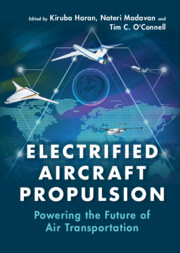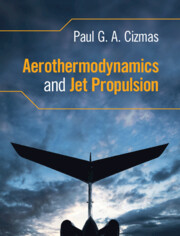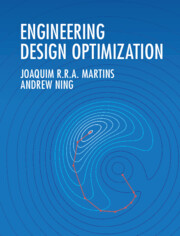Refine search
Actions for selected content:
2076 results in Aerospace engineering
7 - Electrochemical Energy Storage and Conversion for Electrified Aircraft
-
-
- Book:
- Electrified Aircraft Propulsion
- Published online:
- 11 May 2022
- Print publication:
- 26 May 2022, pp 190-223
-
- Chapter
- Export citation
Contributors
-
- Book:
- Electrified Aircraft Propulsion
- Published online:
- 11 May 2022
- Print publication:
- 26 May 2022, pp xiii-xiv
-
- Chapter
- Export citation
Preface
-
- Book:
- Electrified Aircraft Propulsion
- Published online:
- 11 May 2022
- Print publication:
- 26 May 2022, pp xv-xviii
-
- Chapter
- Export citation
1 - Benefits of Electrified Propulsion for Large Aircraft
-
-
- Book:
- Electrified Aircraft Propulsion
- Published online:
- 11 May 2022
- Print publication:
- 26 May 2022, pp 1-28
-
- Chapter
- Export citation
4 - Superconducting Machines and Cables
-
-
- Book:
- Electrified Aircraft Propulsion
- Published online:
- 11 May 2022
- Print publication:
- 26 May 2022, pp 88-129
-
- Chapter
- Export citation
6 - Cryogenic Power Electronics
-
-
- Book:
- Electrified Aircraft Propulsion
- Published online:
- 11 May 2022
- Print publication:
- 26 May 2022, pp 150-189
-
- Chapter
- Export citation
Index
-
- Book:
- Electrified Aircraft Propulsion
- Published online:
- 11 May 2022
- Print publication:
- 26 May 2022, pp 294-298
-
- Chapter
- Export citation
Copyright page
-
- Book:
- Electrified Aircraft Propulsion
- Published online:
- 11 May 2022
- Print publication:
- 26 May 2022, pp iv-iv
-
- Chapter
- Export citation
8 - Thermal Management of Electrified Propulsion Systems
-
-
- Book:
- Electrified Aircraft Propulsion
- Published online:
- 11 May 2022
- Print publication:
- 26 May 2022, pp 224-255
-
- Chapter
- Export citation
9 - Performance Assessment of Electrified Aircraft
-
-
- Book:
- Electrified Aircraft Propulsion
- Published online:
- 11 May 2022
- Print publication:
- 26 May 2022, pp 256-293
-
- Chapter
- Export citation
Dedication
-
- Book:
- Electrified Aircraft Propulsion
- Published online:
- 11 May 2022
- Print publication:
- 26 May 2022, pp v-vi
-
- Chapter
- Export citation
2 - Aircraft Electric Power System Design, Control, and Protection
-
-
- Book:
- Electrified Aircraft Propulsion
- Published online:
- 11 May 2022
- Print publication:
- 26 May 2022, pp 29-48
-
- Chapter
- Export citation
Contents
-
- Book:
- Electrified Aircraft Propulsion
- Published online:
- 11 May 2022
- Print publication:
- 26 May 2022, pp vii-xii
-
- Chapter
- Export citation

Electrified Aircraft Propulsion
- Powering the Future of Air Transportation
-
- Published online:
- 11 May 2022
- Print publication:
- 26 May 2022

Aerothermodynamics and Jet Propulsion
-
- Published online:
- 14 January 2022
- Print publication:
- 02 December 2021
-
- Textbook
- Export citation

Engineering Design Optimization
-
- Published online:
- 05 January 2022
- Print publication:
- 18 November 2021
-
- Textbook
- Export citation
Contents
- from 9 - Classification of Rocket Propulsion Systems
-
- Book:
- Aerothermodynamics and Jet Propulsion
- Published online:
- 14 January 2022
- Print publication:
- 02 December 2021, pp 403-423
-
- Chapter
- Export citation
Appendix B - Thermodynamic Properties Tables for Air
-
- Book:
- Aerothermodynamics and Jet Propulsion
- Published online:
- 14 January 2022
- Print publication:
- 02 December 2021, pp 449-453
-
- Chapter
- Export citation
Contents
- from 10 - Chemical Rocket Performance
-
- Book:
- Aerothermodynamics and Jet Propulsion
- Published online:
- 14 January 2022
- Print publication:
- 02 December 2021, pp 424-446
-
- Chapter
- Export citation
8 - Thrust Augmentation
- from Part II - Air-Breathing Engines
-
- Book:
- Aerothermodynamics and Jet Propulsion
- Published online:
- 14 January 2022
- Print publication:
- 02 December 2021, pp 381-381
-
- Chapter
- Export citation
